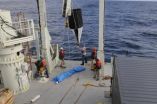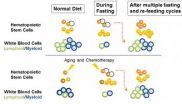(Press-News.org) Phytoplankton—tiny, photosynthetic organisms—are essential to life on Earth, supplying us with roughly half the oxygen we breathe. Like all other life forms, phytoplankton require the element phosphorus to carry out critical cellular activity, but in some parts of the world's ocean, P is in limited supply. How do phytoplankton survive when phosphorus is difficult to find?
Phytoplankton can alter their biochemical make-up according to the availability of nutrients in the water. When phosphorus (P) is particularly abundant in the water, phytoplankton produce and store a form of P called polyphosphate, or poly-P, to use later during times when P is less abundant. The accepted wisdom has been that poly-P was would be found stored by micro-organisms in waters where P was abundant and would be scarce in waters depleted of P. But when a group of researchers from the Woods Hole Oceanographic Institution (WHOI) and the Bigelow Laboratory for Ocean Sciences tested that notion, conducting the most comprehensive survey of poly-P content and distribution in the western North Atlantic, what they found was surprising.
Rather than finding low levels of poly-P in the phytoplankton in the Sargasso Sea where P is scarce, they found the phytoplankton were enriched with poly-P when compared to those in the nutrient rich waters in the western North Atlantic – the opposite of what they had expected. They also found that in low-P environments, poly-P was more readily recycled from sinking particles, retaining it in shallower waters where phytoplankton live and making it available for their use.
"We've know that Poly-P existed in phytoplankton for a very long time. The conventional wisdom that phytoplankton made more Poly-P when they had more phosphorus just made so much intuitive sense that few people have worked on this molecule," said WHOI marine chemist Ben Van Moy, the corresponding author on the study. "However, there were a few hints in the literature that the whole story on poly-P was not completely wrapped up. We certainly didn't set out thinking that we might upend current thinking, and it took us a long time before we would believe our own results. I think the larger message from fundamental discoveries like this is that we have so much more to learn about phosphorous and how phytoplankton deal with its scarcity in certain regions of the sea. Hopefully this paper will be a launching point for a lot of exciting science."
The study, "Accumulation and enhanced cycling of polyphosphate by Sargasso Sea plankton in response to low phosphorus," was recently published in the Proceedings of the National Academy of Sciences (PNAS).
INFORMATION:
The work was supported by a Doherty Postdoctoral Scholarship and the National Science Foundation.
The Woods Hole Oceanographic Institution is a private, non-profit organization on Cape Cod, Mass., dedicated to marine research, engineering, and higher education. Established in 1930 on a recommendation from the National Academy of Sciences, its primary mission is to understand the ocean and its interaction with the Earth as a whole, and to communicate a basic understanding of the ocean's role in the changing global environment. For more information, please visit http://www.whoi.edu.
How do phytoplankton survive a scarcity of a critical nutrient?
New study up-ends conventional wisdom
2014-06-05
ELSE PRESS RELEASES FROM THIS DATE:
Stimulating a protein in skin cells could improve psoriasis symptoms
2014-06-05
Psoriasis is a common, long-lasting disease that causes itchy or sore patches of thick, red skin with silvery scales. Environmental contaminants can trigger psoriasis and other autoimmune disorders, and it is thought that a protein called the aryl hydrocarbon receptor (AhR), which senses environmental toxins, could play a role. A study published by Cell Press on June 5 in the journal Immunity shows that the severity of inflammation associated with psoriasis is unexpectedly suppressed by AhR. The findings suggest that stimulation of AhR could improve symptoms and may represent ...
Neurons transplanted into Parkinson's-affected brains appear healthy after 14 years
2014-06-05
When transplanted into the midbrains of adult patients with Parkinson's disease, dopamine neurons derived from fetal tissue can remain healthy for many years. The findings reported in the Cell Press journal Cell Reports on June 5th suggest that transplanted neurons don't degenerate over time as some had suggested and feared they would, which provides further rationale for pursuing stem cells as a source for transplant-ready dopamine neurons, according to the researchers.
"Our findings show a robust expression of dopamine transporters and a lack of abnormal mitochondrial ...
Activating the immune system could treat obesity and diabetes
2014-06-05
Obesity is a worldwide epidemic that is causing alarming rates of diabetes and cardiovascular disease, but currently there is a lack of effective drug treatments. Two unrelated studies published by Cell Press June 5th in the journal Cell reveal an important role for immune pathways in activating good types body fat, called brown and beige fat, which burn stored calories, reduce weight, and improve metabolic health. The findings could pave the way for much-needed treatments for obesity and related metabolic diseases.
"The idea that metabolic health can be improved by activation ...
Fasting may help protect against immune-related effects of chemotherapy and aging
2014-06-05
While chemotherapy can save lives, it can also cause many side effects, including the depletion of immune cells. Also, even in the absence of chemotherapy, normal aging takes a heavy toll on the immune system, leading to immune deficiencies and a higher risk of developing leukemia and a variety of malignancies with age. Now researchers reporting in the June 5th issue of the Cell Press journal Cell Stem Cell have found that a simple dietary intervention—periodic fasting—may combat both chemotherapy-induced and aging-related changes in immune cell function by replenishing ...
Outcomes of a 2-year national rare disease gene discovery project
2014-06-05
OTTAWA, ON – June 5, 2014 – As part of the Finding of Rare Disease Genes (FORGE) research project, Canadian researchers have developed an expertise in understanding the underlying biology of rare childhood disorders. The first public commentary of this nationwide study is available today in the American Journal of Human Genetics.
"When we launched this project, we predicted we might explain, or solve, 50 disorders; we've almost tripled that goal," said Dr. Kym Boycott, lead investigator of FORGE and clinician scientist at the Children's Hospital of Eastern Ontario ...
First 3-D pterosaur eggs found with their parents
2014-06-05
Researchers have discovered the first three-dimensionally preserved pterosaur eggs in China. The eggs were found among dozens, if not hundreds, of pterosaur fossils, representing a new genus and species (Hamipterus tianshanensis). The discovery, described in the Cell Press journal Current Biology on June 5, reveals that the pterosaurs—flying reptiles with wingspans ranging from 25 cm to 12 m—lived together in gregarious colonies.
Xiaolin Wang of the Chinese Academy of Sciences' Institute of Vertebrate Paleontology and Paleoanthropology says it was most exciting to find ...
McLean Hospital researchers see promise in transplanted fetal stem cells for Parkinson's
2014-06-05
BELMONT, MA -- Researchers at Harvard-affiliated McLean Hospital have found that fetal dopamine cells transplanted into the brains of patients with Parkinson's disease were able to remain healthy and functional for up to 14 years, a finding that could lead to new and better therapies for the illness.
The discovery, reported in the June 5, 2014 issue of the journal Cell Reports, could pave the way for researchers to begin transplanting dopamine neurons taken from stem cells grown in laboratories, a way to get treatments to many more patients in an easier fashion.
"We ...
Fasting triggers stem cell regeneration of damaged, old immune system
2014-06-05
In the first evidence of a natural intervention triggering stem cell-based regeneration of an organ or system, a study in the June 5 issue of the Cell Press journal Cell Stem Cell shows that cycles of prolonged fasting not only protect against immune system damage — a major side effect of chemotherapy — but also induce immune system regeneration, shifting stem cells from a dormant state to a state of self-renewal.
In both mice and a Phase 1 human clinical trial, long periods of not eating significantly lowered white blood cell counts. In mice, fasting cycles then "flipped ...
Immune system molecules may promote weight loss, UCSF study finds
2014-06-05
The calorie-burning triggered by cold temperatures can be achieved biochemically – without the chill – raising hopes for a weight-loss strategy focused on the immune system rather than the brain, according to a new study by UC San Francisco researchers.
The team determined that two signaling molecules secreted by cells of the immune system trigger the conversion of fat-storing white fat cells to fat-burning beige fat cells. Ajay Chawla, MD, PhD, an associate professor of medicine at the UCSF Cardiovascular Research Institute, led the study, published online June 5, 2014 ...
Scientists generate long-sought molecular map of critical genetic machinery
2014-06-05
LA JOLLA, CA—June 5, 2014—A team led by researchers at The Scripps Research Institute (TSRI) has used advanced electron microscopy techniques to determine the first accurate structural map of Mediator, one of the largest and most complex "molecular machines" in cells.
Mediator is crucial for the regulation of most genes' activity and works in the cells of all plants and animals. The mapping of its structure—which includes more than two dozen unique protein subunits—represents a significant advance in basic cell biology and should shed light on medical conditions involving ...
LAST 30 PRESS RELEASES:
Exploring how patients feel about AI transcription
Category ‘6’ tropical cyclone hot spots are growing
Video: Drivers struggle to multitask when using dashboard touch screens, study finds
SLU research shows surge in alcohol-related liver disease driving ‘deaths of despair’
Rising heat reshapes how microbes break down microplastics, new review finds
Roots reveal a hidden carbon pathway in maize plants
Membrane magic: FAMU-FSU researchers repurpose fuel cells membranes for new applications
UN Member States pledge to increase access to diagnosis and inhaled medicines for the 480 million people living with COPD
Combination therapy shows potential to treat pediatric brain cancer ATRT
Study links seabird nesting to shark turf wars in Hawai‘i
Legal sports betting linked to sharp increases in violent crime, study finds
Breakthrough AI from NYUAD speeds up discovery of life-supporting microbes
New Eva Mayr-Stihl Foundation funding initiative boosts research at University of Freiburg on adaptation of forests to global change
The perfect plastic? Plant-based, fully saltwater degradable, zero microplastics
Bias in data may be blocking AI’s potential to combat antibiotic resistance
Article-level metrics would provide more recognition to most researchers than journal-level metrics
Satiety’s little helper: Protein that supports appetite regulating protein identified
UF dives deep into predicting storm damage with computer models
A stormy ocean voyage yields insights on the global carbon cycle
Scientists identify first non-coding gene that controls cell size
Demonstration of altermagnetism in RuO₂ thin films -- A new magnetic material for the AI era
Penn researchers awarded $25M to conduct trial using smartphones to fight heart disease
PCORI awards funding for new patient-centered healthcare research
Exploring the origins of the universe: 145 low-noise amplifiers complete ALMA telescopes
Empress cicada wings help illuminate molecular structure
Using sound waves to detect helium
Time burden in patients with metastatic breast and ovarian cancer from clinic and home demands
Researchers discover bias in AI models that analyze pathology samples
Scientists ID potential way to prevent brain injuries from triggering Alzheimer's
MASTER 2nd Open Call: Execution period kick-off
[Press-News.org] How do phytoplankton survive a scarcity of a critical nutrient?New study up-ends conventional wisdom



